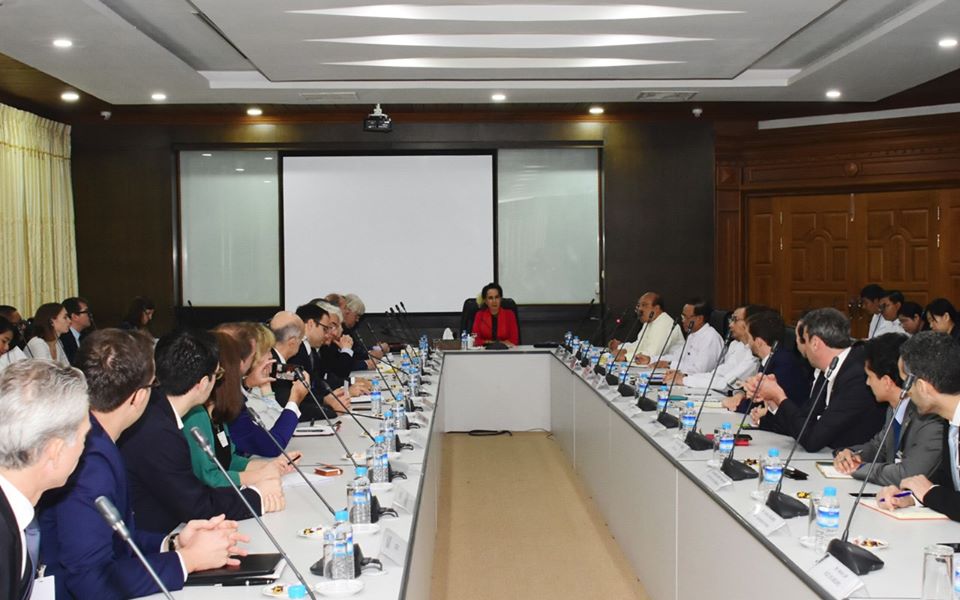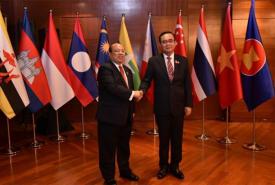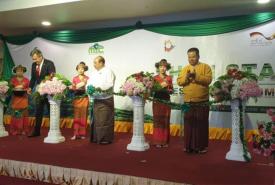24 May
Elevating the growth rate of national economy: MIFER
By Shin Min, Photo: MIFER
With the main objectives to attract more investment into the country to boost national development and to systematically handle the aids, the assistances and the loans, the Ministry of Investment and Foreign Economic Relations (MIFER) is working in top gear.
In harmony and balanced manner with the Myanmar Sustainable Development Plan (MSDP) projects as well as the Myanmar Investment Promotion Plan (MIPP), the MIFER is shouldering for the creation of better investment environment and interacting efficiently with the international economic organizations.
An interview is called on the Union Minister U Thaung Tun, and that the fourth year performances of the MIFER are submitted to the esteemed readers and the people.
Q: Kindly tell us first on the functions of the Ministry of Investment and Foreign Economic Relations (MIFER).
A: In raising the local and foreign investment along with the smooth functioning of businesses, and balanced flow of foreign financial aids and technical expertise, we formed the Ministry of Investment and Foreign Economic Relations (MIFER) on 19 November 2019.
We incorporated the Directorate of Investment Company Administration (DICA) and the Foreign Economic Relations Department (FERD) from the Ministry of Planning and Finance into our ministry.
The MIFER has undertaken the two main tasks such as that of the creation of better investment environment in harmony with the MSDP and the MIPP; and that of the effective and successful cooperation with the international economic organizations.
For the smooth and effective functioning of the MIFER, one Deputy Minister has been inducted in the ministry.
Regarding the matters on the international development aids and the international technical cooperation, the FERD is shouldering the duties, while the inflow of investment is being handled by the DICA.
Over the years since the formation of the MIFER, endeavor and effort is the main push of the ministry in building reliance and trust of the local and foreign investors. The push is to keep up and carry on in top gear.
Q: Please share us on the part of raising local and foreign investment and the economic cooperation activities.
A: As a developing nation, it is customary to garner the available domestic financial resources of the country as well as attracting foreign investment, the development assistance, and the foreign loans.
Looking into the main functions of the MIFER, it has the obligation for inviting local and foreign investors in one hand, and on the other hand, it needs to negotiate with international partners in securing aids and assistances and also soft loans to be used in the country’s political, economic and social sectors.
Aim, target and goal for the formation of MIFER are to invite foreign investment steadfastly and strenuously and also to work on categorically and closely in securing aies, assistances and soft loans for the country.
Three main components are there in working with the international development partners.
First and foremost, it is ongoing smooth cooperation with the UN and its agencies with the departments, reflecting with the fine implementation of 2018 – 2022 Five-Year Country Program meticulously drafted between the UNDP and the relevant ministries.
Secondly, the ADB and the World Bank are giving soft loans for the development of Myanmar as well as providing technical skills, policy advocacy and project implementation.
Moreover, European Union supported education in Myanmar with EUR (221) million to provide equal accesses to better quality education for all Myanmar students in April 2019.
Browsing over the ASEAN cooperation, Myanmar follows after Singapore in the country wise implementation of 2019 ASEAN economic sphere.
ASEAN has five free trade agreements (FTAs) with six Dialogue Partners, namely China, Japan, Republic of Korea, India, and Australia and New Zealand, and that the cooperation is going ahead for more investment.
The Regional Comprehensive Economic Partnership (RCEP) is a proposed agreement between the member states of the Association of Southeast Asian Nations (ASEAN) and its free trade agreement (FTA) partners of (6) countries.
The pact aims to cover trade in goods and services, intellectual property, etc; and that it is expected to sign in 2020.
Myanmar is poised to enter in an international trade agreement for opening up opportunities for the people of Myanmar.
Thirdly, we have witnessed tangible improvements in bilateral cooperation. During the visit of Chinese President Xi Jinping to Myanmar, many agreements have been signed and that in the next (3) years Yuan (4) billion is in the pipeline.
Similarly, we have signed agreements with Japan such as that of aids and assistances programs; that of human resources development programs; and that of other assistances projects.
In September 2019, Myanmar and ROK signed the framework agreement under which South Korea will provide US$ (1) billion to Myanmar for an economic development cooperation fund (EDCF) during a visit by South Korean President Mr Moon Jae-in. The implementation is now in progress.
European Union member countries namely Germany, France, Switzerland, Czech Republic, Denmark, Austria and Netherlands as well as Australia and New Zealand are stepping in and come together for cooperation in elevating for the sectors such as education, healthcare and human resources.
Q: Please elaborate on the citizen’s investment from domestic sphere and the foreign investment.
A: During 2018 – 2019 fiscal year, 282 foreign enterprises were approved by the Myanmar Investment Commission (MIC) with the total foreign investment amount of US$ (2 point 764) billion.
Total of (97) foreign enterprises with ongoing projects have been approved with additional investment of US$ (1 point 394) billion.
Moreover, (16) projects in Thilawa Special Economic Zone have been approved with investment of US$ (0 point 362) billion. Therefore, the foreign investment for 2018 – 2019 fiscal year stands at (4 point 520) billion.
With regards to Myanmar citizen investment, total of (169) enterprises have been approved with investment MMK (1,434) billion including US$ (381 point 638) million.
Total of (25) ongoing projects have been approved with MMK (256 point 459) billion including US$ (91 point 647) million. Total amount stands at MMK (1,691 point 332) billion including US$ (473 point 285) million.
Q: Kindly explained us on the approved domestic and foreign investment projects in the country and that of the job opportunities created out of it.
A: 2018 – 2019 saw the transport and communication sector at the top in investment; covering (36 point 99) percent. The industry sector covers (32 point 41) percent. Other service sector embraces (15 point 70) percent.
Myanmar citizen investment covers (24 point 04) percent in industry sector and stands top in the list.
Service industry stands at number two slot with (19 point 62) percent.
The third slot is occupied by animal breeding and fisheries with (12 point 62) percent.
Looking into the statistics on job opportunities, the foreign investment projects employed (170,330) workers, and that Myanmar citizen investment appointed (19,193) employees, totalling (189,523) workforce.
Q: Please tell us the countries that invested in Myanmar.
A: I would like to split in two parts on foreign investments.
During 2018 – 2019 fiscal year, based on the merits of total volume, there are (51) countries invested in Myanmar, and that Singapore, PR China, Thailand and Hong Kong stood at the forefront.
In the second part, I would like to highlight the inflows of investment during 2018 – 2019 single fiscal year compared to the same period of previous fiscal year. It has been recorded as a significant surge in that year.
Especially, the Asian countries namely Singapore, Thailand, and Hong Kong running at the forefront, while western countries such as Britain, Netherlands, France, Switzerland, and United States joined the bonanza with more investment.
Q: Tell us on the measures for raising investment.
A: Seriously taken up, the Myanmar Investment Commission has been convening roadshows in (6) foreign countries for (11) events, with (29) domestic presentations; totaling (40) showcasing of local and foreign investment in an attractive or favourable way.
The Myanmar Investment Promotion Plan (MIPP) was drafted in accordance with the 2016 Myanmar Investment Law, and approved on 25 July 2018. The launching ceremony was held at the Sedona Hotel in Yangon in October 2018 in order to improve the responsible investment and to attract more than US$ 200 billion next 20 years.
With a view to smooth implementation of MIPP, the MIFER formally launched the Investment Promotion Committee (IPC) at a ceremony held in Nay Pyi Taw on 25 June 2019.
Q: Kindly share on the current foreign investment objectives of 2019 – 2020 fiscal year compared to previous years.
A: Expectation is set at US$ (5 point 8) billion for 2019 – 2020.
As of 9 April 2020, US$ (3 point 367) billion have been approved, inclusive of Thilawa Special Economic Zone, and therefore, the anticipation could be realized.
Looking back the statistics of last year, the same period showed US$ (1 point 988) billion, and it is safe to say the foreign investment is outpouring.
Q: Kindly explain over the electronic registration of companies.
A: New company registrations can be completed via Myanmar Companies Online (MyCO), following the commencement of the Myanmar Companies Law (2017).
Established by DICA, MyCO acts as a public registry of all companies and entities registered under the Myanmar Companies Law.
With the installation of MyCo, Myanmar climbed up the ranking in “Doing Business Report (2019)” from (152) to (70) in “Doing Business Report (2020)”.
During the period from 1 August 2018 to 29 February 2020, total of (67,898) companies have been registered, and that between (1,400) to (1,500) companies are keep coming in for registration.
On 14 February 2020, Myanmar passed its new Insolvency Law, which aims to introduce a modern insolvency regime for investors and entrepreneurs.
In this connection, separate registry system is to be created for the insolvency practitioners; and those unregistered companies that falls under individual / MSME category.
Plans are underway for implementation such as that of drafting the “Corporate Governance Principle”; that of establishing “Coordinator Office of Myanmar” for EITI matters; that of the compiling and releasing of relevant documents in connection with “Beneficial Ownership” in collaboration with the Anti-Money Laundering Central Committee of Myanmar. The “Investment Proposal Online System” and the “Online Investment Monitoring Application” are on the table for launching as soon as possible.
Q: Please tell us the possible impact on our economy by COVID – 19 pandemic and the measures for recovery.
A: The pandemic brings in some impact on economy in those countries that have linkage and hook up with the PR China. As Myanmar has profuse economic connectivity with China, we have felt the economic impact.
It hits hard in the manufacturing sector, the hotel industry, and the tourism sector. That is why we rushed in the tasks in the formation of National-Level Central Committee on Prevention, Control and Treatment of Coronavirus Disease. We continued the fight against the virus continuously without interruption or gaps.
The Working Committee, formed on 13 March 2020, to address the impact of Coronavirus Disease 2019 (COVID-19) on the Country’s Economy was held at the Directorate of Investment and Company Administration (DICA) in Yangon on 15 March 2020.
The Government took action to mitigate the impact of COVID-19 on the economy on 18 March 2020, as set out in Notification No. 1/2020. The MIFER then held a coordination meeting of the working committee to remedy economic repercussions caused by COVID-19 and that the Ministry of Planning, Finance and Industry then announced the steps to resolve the effects on Myanmar’s economy.
At the meeting (2 / 2020), the initial relief fund is raised at MMK (100) billion, and that businesses hit by COVID- 19 would be offered with (1) per cent loan interest rate for (1) year.
Beginning 9 April 2020, businesses that applied loans were given loans to (85) in the first group; (113) in the second group; and (111) in the third group. The mitigation works would be continued.
In conclusion, the Government on 27 April 2020 announced the COVID-19 Economic Relief Plan (“the plan”). The document talks about various action points by various government entities that will provide aid and relief in Myanmar in view of the COVID-19 pandemic.
Translated by UMT (Ahlon)







